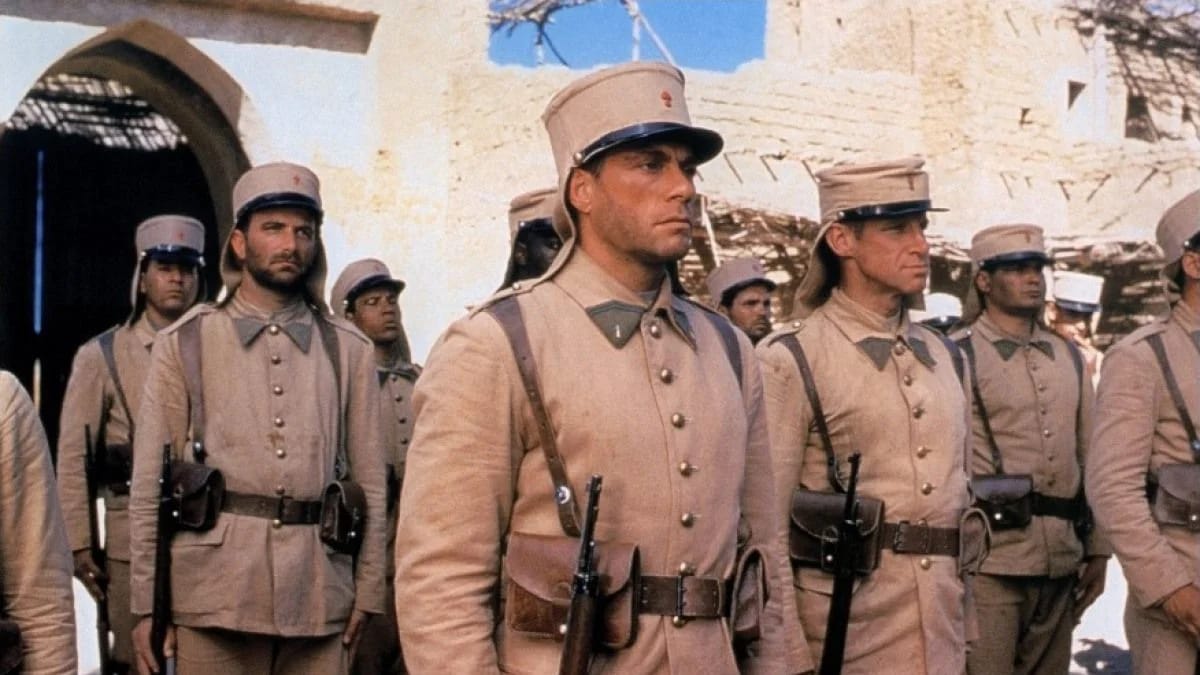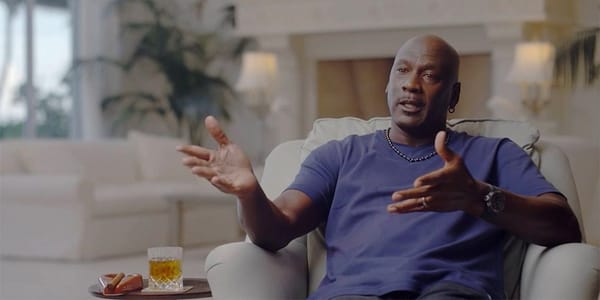On <i>Legionnaire</i>, JCVD's film maudit

Director Peter Macdonald and executive assistant Madelyn Most discuss one of the best and most forgotten of JCVD's films
There’s simply nothing expected about Legionnaire. It’s not directed by an ‘auteur’, but by Peter MacDonald, an industry veteran known predominantly for his work as a second-unit action director on movies like The Empire Strikes Back straight through to Guardians of the Galaxy. It’s a Jean-Claude Van Damme vehicle, but you won’t find the splits, the beat-’em-up plot, or the cheeky winks and nods to the camera. Its conclusion is downbeat; its plot, based in real history.
The film opens with a masterful tracking shot around an extravagant speakeasy circa 1925, where headstrong prizefighter Alain (Van Damme) finds himself in a tangle with a dangerous Marseille gangster. With few options left to him, Alain absconds to French Morocco with the Foreign Legion, who ask no questions about a man’s past. As the opening titles inform us, the Legion was composed of notorious mercenaries, hired with little care for their backgrounds or nationality and sent to do the nastiest work of the French colonial regime.
Shot by DP Douglas Milsome (Full Metal Jacket), Legionnaire combines the old-school, sweeping adventure tale (think Lawrence of Arabia or Gunga Din) with a dark awareness of the harsh realities of life in the Legion. (‘We are invaders. This is their country,’ says one soldier to another about the Berber tribesmen who they are fighting.) A strong supporting cast fills in an ensemble of ragtag crew around Van Damme, including Stephen Berkoff as a martinet officer and most memorably Adewale Akinnuoye-Agbaje as Luther, an American who has escaped the US during the worst offenses of Jim Crow and a false murder charge. A tragic performance from Nicolas Farrell as a well-to-do Englishman running from his past only further anchors Van Damme — the star is forced to be the best he’s ever been, and he rises to the challenge.
But all of this could not help a confused audience — or any major distributors — figure out what to do with a considered, handsomely-made period piece starring the Muscles from Brussels. Legionnaire was sadly destined to become a film maudit: it is one of the most expensive films ever to go straight to video, upon its release in 1998. In the following transcribed video chat from their home in France, I spoke to director Peter MacDonald and Madelyn Most, his executive assistant on the film, about shooting in the Sahara, the crazy real-life legionnaires they regretted inviting onset, Jean-Claude Van Damme’s backside, and most importantly: what happened to this unsung classic of the 1990s?
Christina Newland (CN): I guess we should start with how you first took on the role of director on Legionnaire.
Peter MacDonald (PM): It was a project that was close to Jean-Claude for a very long time. The romance, the desert; he looked good in uniform. I’d worked with him on bits and pieces before, and we had a very good relationship. Like most actors, he could be a bit of a problem, but I think I was more like a father figure — or a grandfather figure — to him. So he got together with Sheldon Lettich on the script, but [...] it soon became clear that Sheldon’s vision wasn’t really big enough. Jean-Claude and I wanted the beautiful location-shooting in Morocco. So I was asked if I wanted to be the director, and I must say I was a little reluctant. I wasn’t sure if it was the kind of film I wanted to do. But Jean-Claude persuaded me, and I guess ego took over, so I became the director.
CN: Why weren’t you sure it was the kind of film you wanted to do?
PM: Well, a lot of the old films about the French Foreign Legion were… a little corny. I wasn’t interested in making that. So I got an old veteran legionnaire to come in and talk to Jean-Claude, and he explained what the Legion was like. It had very little in common with what you usually saw on film. It was a very tough existence. But my feeling is that I wanted to use the beauty and magic of the Sahara Desert in the film. Like in Lawrence of Arabia — it is the most beautiful environment that can just change overnight. There are sand dunes there and then in the morning they’re gone and something else is there. It’s ever-changing. So I really wanted to make that part of the film.
CN: So how did you balance the project you want to make with what was someone else’s brainchild?
PM: We tried to make the story as honest and believable as possible. There were a lot of lost souls who would join the Legion for safety, to get away from trouble, and also to be in a place where no one was really gonna try and find them. But sometimes, the money people wanted me to do things I didn’t feel were believable. I didn’t want JCVD doing the splits and knocking people off camera.
Madelyn Most (MM): But he did insist on being nude in the shower scene.
CN: He was very proud of his posterior, wasn’t he?
PM: It’s the only time all the women seemed to come on the set. Eight naked men in the shower. Jean-Claude always said a shot of his bum was worth a million dollars at the box office. I said if that’s the case we’ll keep your trousers off all the time, because we need the money! But then, in the shower scene, he was the only one who was shy. We didn’t show too much, but Jean-Claude came on with his back to me, and he had a sock over his willy. I said, what are you doing? I can hide your willy, I can’t hide a big wet sock hanging there!
CN: You have a wonderful supporting cast in this film.
PM: I was determined to have a really top cast. Stephen Berkoff is this kind of force of nature, who kept everyone on their toes. And Nicolas Farrell is just amazing. I don’t think Jean-Claude had ever been surrounded by that much active talent. It was good for him. He really had to be on the ball, because they all stayed in position so he could react to them. It also meant he had to do the same for them. There was more discipline than I think Jean-Claude had ever experienced before.
CN: Can you tell me about your visual approach to the movie, and how you aimed to shoot the film?
PM: A friend of mine and I storyboarded all the main sequences, but I don’t necessarily feel I need them. I’ve been a cameraman all these years, so I can visualise what I need. But it’s useful for the crew. We had scouted these beautiful locations, and got the art department to build us a fort right on the edge of the desert. Then I had to make sure the crew understood it was going to be tough, because it was 120 degrees.
MM: The budget was, I think, under 15 million dollars. And it looks like 40, 50 million. The battle scenes Peter did — with hundreds of horses and horsemen out in the desert, with the dust and sound — were ridiculously difficult. But Peter surrounded himself with the best in the business. Our production designer Charlie Wood took months building the fort seen at the end of the movie, and it’s still out there in Morocco today. But the battles, the silhouettes, the horizons... It’s a gorgeous film to watch.
CN: How do you best describe what happened with the film once it was finished, and why it didn’t make it onto the big screen?
PM: When we screened it, it looked so polished and magnificent. But the public weren’t expecting this from Jean-Claude. They were so used to him doing a certain thing in his films. They weren’t ready for him to become who he became in that film. But then, Miramax — Harvey Weinstein — wanted to come in. They wanted to make some cuts — only small changes, maybe one more day of shooting. I said yes. I thought the changes they wanted would have made the film better. But Ed Pressman, the producer, wouldn’t agree to that. So they walked away, which was a great pity. We would have gotten great distribution, and more money for post-production.
CN: How do you see the film today? Do you look back at it any differently to how you did directly after?
MM: With this film, if you were shooting for fourteen hours a day, you had another ten hours of drama along with it. We invited this one real legionnaire on the set to teach the cast the old songs and things, and he was… crazy. He kept telling stories about fucking pigeons. The drama behind the camera was bigger than what's on screen! It's amazing that it came out so well.
PM: When you’re shooting, sometimes for 14 hours a day, in difficult conditions, and sometimes Jean-Claude wasn’t behaving, there’s a lot to worry about. So it’s only when you see the first edit, with an audience, where you get a feel for it. When you sit with an audience. And I did, with a big crowd in Westwood, CA and nobody knew who I was. I think we were all quite proud of what we did, and disappointed it didn’t get the distribution it deserved. The audience wasn’t ready for Jean-Claude the actor, they wanted Jean-Claude the action man.
CN: You can’t speak for him, of course, but I wonder if he feels the same.
PM: I think he’s very proud of it. When we had a crew screening, his parents came. And they said it’s the best thing you’ve ever done, Jean-Claude, because it’s not what people expect. And even for someone like Jean-Claude, if your mum and dad give you praise…
CN: What do you wish people knew about Legionnaire?
PM: I’m really proud of it, and of all the actors. Even the minor parts come off really well indeed. I was upset that the distribution was screwed up. I only saw it once on the big screen, and I thought it had a really good look. On TV, it looks okay. But seeing it on a big widescreen in a cinema? It looked fantastic.




